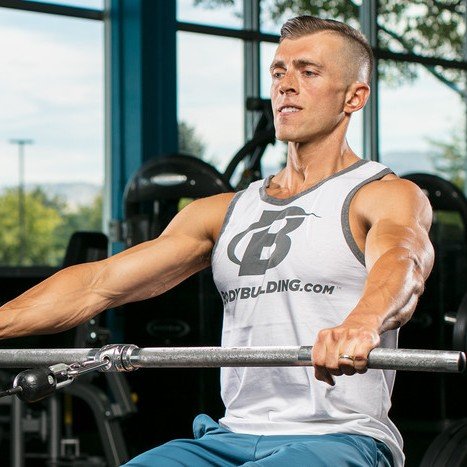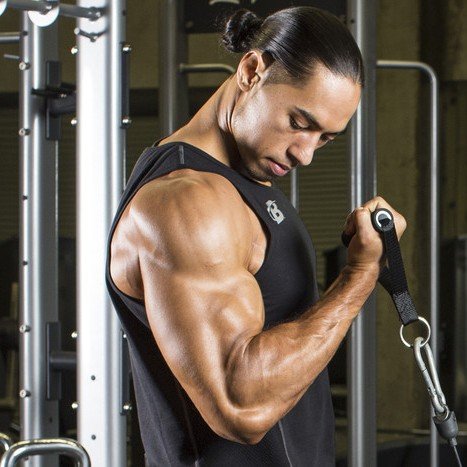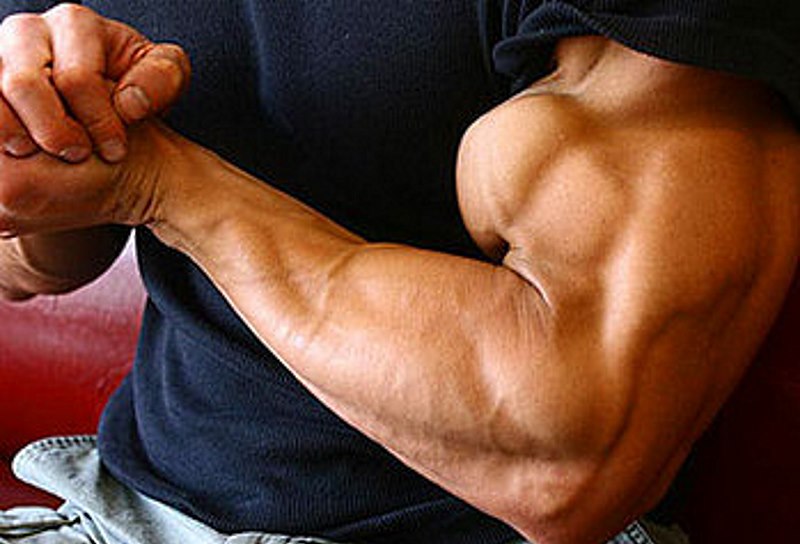I'd make a lousy burglar because I don't like big guard dogs with big sharp teeth. That doesn't mean I'm opposed to stealing when the potential payoff is big enough. But instead of using crowbars or safe-cracking tools, I use an iPhone.
My latest heist involved Tom Graff, an up-and-coming physique athlete from Boise, Idaho. Tom is always experimenting with interesting new movement variations. A couple really caught my eye, so, phone in hand, I "borrowed" some for my own workout (with Tom's full cooperation, of course).
Rather than horde all of this great stuff for myself, I'm ready to share the seven best variations I saw.
1. Front Machine Raise
About the Move: I'm always intrigued by the way lifters use machines in unintended ways, and Tom has found a novel one here. By lifting while facing the back pad of the Hammer seated shoulder press, Tom is able to simulate a front raise, nearly duplicating the dumbbells' normal out-and-up pathway.
"When the movement pattern is predetermined, as it is with machines, you don't need to recruit stabilizer muscles to balance the weight, and that means you're better able to isolate the target muscle," says Tom. "The more you can achieve muscle isolation, the greater the opportunity for growth."
Training Tip: Try a few light-weight sets to get a feel for the motion. As with most machine exercises, your joints don't have much freedom to move, so you'll want to find the position that works for you. Your foot position will be determined in part by your arm length.
2. High Row With Handles
About the Move: You can do this one on a Hammer machine, or try it on other equipment. Simply take a pair of cloth handles and attach them over the machine's handles. Make sure they can't come off during execution.
"Using the cloth handles allows me to use a neutral grip to hit my back muscles at different angles and torques," says Tom. "The variation also slightly widens my grip width at the start position, which helps emphasize the upper lats and V-taper."
Cloth handles also enable you to use different grips, including pronation (turning your palms down as you pull) and supination (turning your palms up).
Training Tip: When using the cloth handles, you may lose some range of motion at the upper end and may not be able to fully extend your arms. If that's the case, set the seat to a slightly lower position.
3. Kneeling Side-To-Side Straight-Arm Pull-Down
About the Move: Here's another tweak of a back-day staple.Straight-arm pull-downs are commonly done by pulling the handle straight into both thighs. Tom mixes it up by keeping his arms straight and pulling the handle first to one hip and then to the other.
"This motion recruits the lower lats in an altogether different way," he says. "By extending the normal range of motion on each side, you get better muscle-fiber recruitment and growth."
Training Tip: The big gain from this movement comes toward the lower end of the range of motion, so don't increase the load if it ends up sacrificing overall range. For greater stimulus, hold the bottom position for a count to really intensify the burn.
4. Seated Landmine
About the Move: Landmines are a popular tool for shoulders and back. Tom uses this move to target the inner upper region of the chest, as well as the triceps and front delts. The movement differs from a shoulder press in two respects: You're pressing up and forward instead of just up, and because the load is centered on your midline, you're working your inner-pec region.
Training Tip: This movement is normally done while standing. But Tom's version has you seated on an exercise ball to reduce the momentum you generate using the hips. You'll have to back off from your normal load, but this variation will still work your shoulders and back hard. You can also do this landmine move while kneeling—or even while sitting on a chair.
5. Reverse Hack Squat
About the Move: Normally, hack squats hit the quads. But when you reverse your body position, you're able to push your glutes further back, something you can't do when your rear is supported by the machine. And that changes the target muscles.
"Instead of mostly working the quads," Tom says, "the reversed-body position puts more direct tension on the glute and hamstrings, and especially the tie-in."
Training Tip: Not all machines have a solid foot plate. If your machine doesn't have one, don't try this exercise. If it does, use both wide and narrow stances to emphasize different parts of your legs.
6. Standing Machine Shoulder Press
About the Move: Incline chest-press machines typically hit the front delts, but Tom has found a way to shift focus to both the front and middle delts. By standing and facing a Hammer incline press machine, he's able to simulate a standing military press, but with each arm working independently.
"The movement arc differs from that of other machine overhead presses so the muscle-recruitment pattern is altered and provides opportunity for new growth," says Tom.
Note that Tom's hand position is slightly closer than what he'd be using with a barbell. This closer grip pulls the elbows a bit forward to stimulate more front-delt and less middle-delt activation. It also means that the triceps have to work through a slightly longer range of motion.
Training Tip: "I use this version to really drive blood into the muscle," says Tom. "Since you don't need to focus on balancing the weight nearly as much, you're free to really increase volume." To get into the start position, lift one side at a time.
7. Single-Arm Smith Machine Row
About the Move: Single-arm rows are effective lat builders, but for variety, Tom mimics the movement on the Smith machine."With the dumbbell, your body is stabilized and the weight isn't, so the recipe here is to flip the script," he says. "When you use the Smith machine, the movement is controlled but your body isn't."
Training Tip: To minimize stress on your low back, increase stabilization by putting your opposite hand or forearm atop your knee.
Source: http://www.bodybuilding.com/



